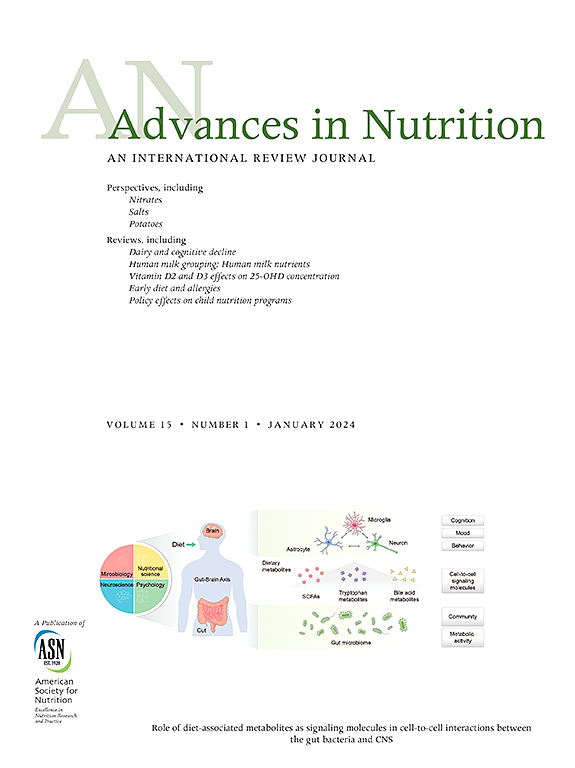地中海饮食的环境和健康可持续性:系统性。
IF 8
1区 医学
Q1 NUTRITION & DIETETICS
引用次数: 0
摘要
地中海饮食(Mediterranean diet,MD)已被证明是一种健康的饮食模式(DP),最近,越来越多的研究将其视为一种可持续的饮食模式。本研究的目的是根据现有的科学文献,从碳足迹、水足迹(WF)、土地利用(LU)和/或能源利用等方面分析地中海饮食是否是一种可持续的健康饮食模式。我们按照 PRISMA 指南进行了系统综述,并在 PROSPERO(CRD42022309916)上进行了注册。我们纳入了 35 项研究:25 项建模研究、7 项横断面研究和 3 项纵向研究。24 项研究比较了 MD 与其他膳食模式的可持续性;21 项研究评估了 MD 与膳食消费数据的可持续性;9 项研究评估了 MD 的坚持率及其对环境的影响。共有 29 项研究分析了 MD 的碳足迹、11 项 LU、20 项 WF 和 7 项能源使用。除环境影响外,有 6 篇文章对饮食的健康方面进行了评估。千年发展目标显示出较高的营养质量,健康评分在 122 分至 178 分之间,营养丰富食物指数在 13.51 分至 90.6 分之间。使用相同测量单位的环境足迹结果,我们能够对最常评估的膳食与 MD 进行定量比较。与其他膳食相比,91% 的研究将 MD 称作可持续发展的膳食,大多数对 MD 的坚持情况进行评估的文章都发现 MD 与环境足迹呈反相关。在温室气体排放(GHGE)方面,MD 的环境足迹为 1.03-5.08 千克二氧化碳当量/人-天;在 WF 方面,为 257.2-2735.2 升/人-天;在 LU 方面,为 4-14.8 平方米/人-天和 2.85-3.32 平方米*年/天。总之,现有证据表明,总体而言,千年发展目标是一个可持续的健康发展目标,与地球健康相一致。本文章由计算机程序翻译,如有差异,请以英文原文为准。
Environmental and Health Sustainability of the Mediterranean Diet: A Systematic Review
The Mediterranean diet (MD) has been shown to be a healthy dietary pattern (DP), and lately it is increasingly being studied as a sustainable DP. The aim of this study is to analyze whether the MD is a sustainable and healthy DP accounting for its carbon footprint, water footprint (WF), land use (LU), and/or energy use, based on the existing scientific literature. We conducted a systematic review following PRISMA guidelines and registered in PROSPERO (CRD42022309916). We included 35 studies: 25 modeling studies, 7 cross-sectional, and 3 longitudinal. Twenty-four studies compared the sustainability of the MD with that of other DPs; 21 assessed the sustainability of the MD compared with dietary consumption data; and 9 evaluated the MD's adherence and its environmental impacts. A total of 29 studies analyzed the carbon footprint, 11 the LU, 20 the WF, and 7 the energy use of the MD. Six articles assessed the health aspect of the diet apart from the environmental impact. The MD showed high nutritional quality, ranging between 122 and 178 points on the health score and between 13.51 and 90.6 points on the nutrient-rich food index. Using the results for environmental footprints in the same measurement units, we were able to quantitatively compare the most frequently assessed diets with MD. When compared with other diets, 91% of the studies referred to the MD as a sustainable DP, and most of the articles in which its adherence was assessed obtained an inverse correlation with the environmental footprints. Environmental footprints of the MD ranged from 1.03 to 5.08 kg CO2-eq/person-day for greenhouse gas emissions, 257.2–2735.2 L/person-day for WF, and 4–14.8 m2/person-day and 2.85–3.32 m2∗year/d for LU. In summary, the available evidence suggests that, in general, the MD is a sustainable and healthy DP, which aligns with planetary health.
求助全文
通过发布文献求助,成功后即可免费获取论文全文。
去求助
来源期刊

Advances in Nutrition
医学-营养学
CiteScore
17.40
自引率
2.20%
发文量
117
审稿时长
56 days
期刊介绍:
Advances in Nutrition (AN/Adv Nutr) publishes focused reviews on pivotal findings and recent research across all domains relevant to nutritional scientists and biomedical researchers. This encompasses nutrition-related research spanning biochemical, molecular, and genetic studies using experimental animal models, domestic animals, and human subjects. The journal also emphasizes clinical nutrition, epidemiology and public health, and nutrition education. Review articles concentrate on recent progress rather than broad historical developments.
In addition to review articles, AN includes Perspectives, Letters to the Editor, and supplements. Supplement proposals require pre-approval by the editor before submission. The journal features reports and position papers from the American Society for Nutrition, summaries of major government and foundation reports, and Nutrient Information briefs providing crucial details about dietary requirements, food sources, deficiencies, and other essential nutrient information. All submissions with scientific content undergo peer review by the Editors or their designees prior to acceptance for publication.
 求助内容:
求助内容: 应助结果提醒方式:
应助结果提醒方式:


